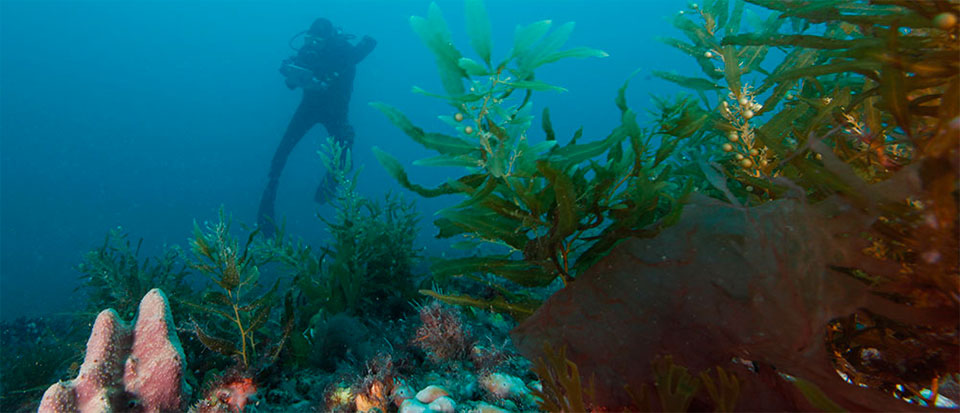Water Quality
Gray's Reef

Why is it a concern?
The past few decades have shown increases in contaminant levels and eutrophication in coastal waterways, but relatively little is known about offshore levels of contamination. Although contaminants may be transported from land across the inner shelf to offshore areas like Gray's Reef, the sanctuary waters have been presumed to be pristine given their distance from contaminant sources. At present, eutrophication does not appear to have the potential to negatively affect living resources or habitat quality, but insufficient data exists to determine whether temporal trends have occurred. The atmosphere is also considered a pathway of contaminants such as heavy metals, persistent organic contaminants and nutrients to the reef. In addition, there is potential for Gulf Stream intrusions to carry contaminants from further south.
The remote nature of the sanctuary reduces the potential for direct impact from human activity on the resources of Gray’s Reef. However, the continued development of the coastal zone is inevitable. The recent confirmation of connectivity between river outflow and surface waters over hard-bottom reefs of the Georgia coast (Cohen and Gleason, unpubl. data) links the health of the sanctuary to development and other activities that occur farther inland. In light of these and other findings, Gray’s Reef National Marine Sanctuary is dedicated to maintaining monitoring and assessment of water quality conditions.
Scientists at Gray's Reef and Skidaway Institute of Oceanography have teamed together to monitor the water quality at Gray's Reef. Researchers conduct routine sampling in GRNMS, both at the surface and bottom of the water column. So far results have shown the contaminants and bacterial levels are within a range that scientists can still consider Gray's Reef pristine.
A recent study investigated the connectivity of the coastal Georgian river, the Altamaha, and the sanctuary by tracking nontoxic, fluorescent dye that was released in to the Altmaha Sound on an outgoing tide (Cohen and Gleason unpubl. data). Three days later, this dye was detected within the boundaries of the sanctuary, suggesting that the Altamaha and other rivers along the Georgia coast can be sources of both nutrients and contaminants for habitats and organisms in the sanctuary.
Overview of Research
| Project Name | PI and contacts | Links |
|---|---|---|
Water Quality Monitoring |
||
Benthic Macroinfaunal Communities and Levels of Chemical Contaminants in Sediments and Biota at Gray's Reef National Marine Sanctuary and Nearby Shelf Waters off the Coast of Georgia |
http://graysreef.noaa.gov/science/publications/pdfs/i-06.pdf |
Science Needs and Questions
- Are specific or multiple stressors, including changing oceanographic and atmospheric conditions, affecting water quality?
- What is the eutrophic condition of sanctuary waters and how is it changing?
- How do coastal conditions influence water quality in the sanctuary?
- Are there particular coastal or human activities that affect water quality conditions in the sanctuary?
- How can GRNMS influence coastal development to the benefit of the resources in the sanctuary, especially water quality?
Education and Outreach Material
Rivers to Reefs: Educators Manual
Rivers to Reefs: Educator Workshop and Materials
Rivers to Reefs Poster: Altamaha River Watershed
Hydrologic Cycle Poster
References
Balthis, W.L., J.L. Hyland, C. Cooksey, M.H. Fulton, and G. McFall. 2007. Long-Term Monitoring of Ecological Conditions in Gray's Reef National Marine Sanctuary: Comparison of Soft-Bottom Benthic Assemblages and Contaminant Levels in Sediments and Biota in spring 2000 and 2005. NOAA Technical Memorandum NOS NCCOS 68. 29 pp.
Cooksey, C.J. Hyland, W.L. Balthis, M. Fulton, G. Scott, D. Bearden. 2004. Soft-bottom benthic assemblages and levels of contaminants in sediments and biota at Gray’s Reef National Marine Sanctuary and nearby shelf waters off the coast of Georgia (2000 and 2001). NOAA Tech. Memo. NOS NCCOS 6. NOAA National Ocean Service, National Center for Coastal Environmental Health and Bimolecular Research, Charleston, SC. 55pp.
Greene, A.K. 2008. Invertebrate Endofauna Associated with Sponge and Octocoral Epifauna at Gray's Reef National Marine Sanctuary off the Coast of Georgia. A thesis Submitted in Partial Fulfillment of the Requirements for the Degree of Master of Science in Marine Biology at the Graduate School of the College of Charleston. 133 pp.
Hyland, J., C. Cooksey, W.L. Balthis, M. Fulton, D. Bearden, G. McFall, and M. Kendall. 2006. The Soft-bottom Macrobenthos of Gray's Reef National Marine Sanctuary and Nearby Shelf Waters off the Coast of Georgia, USA. Journal of Experimental Marine Biology and Ecology. 330: 307-326.

